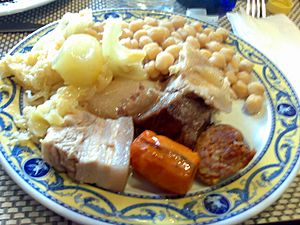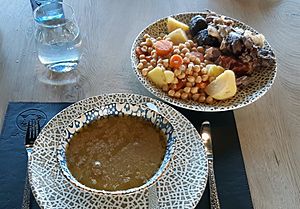Cocido madrileño facts for kids

|
|
| Course | Main course |
|---|---|
| Place of origin | Spain |
| Region or state | Madrid |
| Serving temperature | Hot |
| Main ingredients | Chickpeas |
Cocido madrileño (pronounced "koh-SEE-doh mah-dree-LEH-nyoh") is a very old and popular stew from Madrid, Spain. It's a warm and filling dish made with chickpeas, different kinds of meat, and vegetables. People often enjoy this stew during the cold winter months. However, you can find it served in many restaurants throughout the year.
This dish started as a simple meal for everyday people. But it became so well-loved that it eventually appeared on restaurant menus. Chickpeas, which are a key part of the stew, were first brought to Spain a very long time ago.
Contents
History of Cocido Madrileño
The exact start of Cocido madrileño is not fully known. Most people believe it began during the Middle Ages. It likely developed from an old Jewish dish called adafina. This dish was cooked slowly for a long time. This was important for Jewish families to have warm meals during Shabbat, their day of rest. These early versions of the stew were kosher, meaning they followed Jewish food rules. They used eggs and did not include pork.
Over time, the dish changed. During the 15th and 16th centuries, many people in Spain wanted to show they were Christian. So, they started adding pork to their meals. Soon, ingredients like lard, bacon, chorizo (pork sausage), and morcilla (blood sausage) became part of the stew.
From these beginnings, the recipe for cocido became a classic dish in Madrid. As Madrid grew in the 1800s and 1900s, this stew was a popular choice. It was cheap and very filling, perfect for workers in small restaurants and taverns. After the Spanish Civil War, life became harder. Also, new, faster meals became popular. This made cocido less common for a while.
What's in Cocido Madrileño?
The main ingredient in cocido is the chickpea, also called garbanzo. Many vegetables are also added. These usually include potatoes, cabbage, carrots, and turnips. Sometimes, people also add green beans, Chard, or cardoon.
The meat in cocido is mostly pork. This can be pork belly, fresh chorizo, onion morcilla, and dried jamón serrano (cured ham). Beef shank is also a common addition. People especially like the fatty part of the beef. Chicken, especially older hens, is also part of the stew.
To make the broth even richer, two bone pieces are added. These are usually a ham bone and a beef spine bone.
Some recipes also include a bola. This is like a meatball made from ground beef, bread crumbs, parsley, and other spices. It is thought that the bola was added to replace the eggs used in the old adafina dish.
How Cocido Madrileño is Served
Traditionally, the different parts of cocido are served separately. Each serving is called a vuelco. This word means "tipping out," because the pot is emptied to separate the ingredients for each part.
The first vuelco is the broth from the cocido. It is served with noodles added to it.
The second vuelco is the chickpeas and vegetables.
The third vuelco is all the different kinds of meat.
What to Do with Leftovers
If there are any leftovers from cocido, they can be used to make other tasty dishes. Some traditional meals made from cocido leftovers include Spanish croquettes, ropa vieja (shredded meat dish), and pringá.
See also
 In Spanish: Cocido madrileño para niños
In Spanish: Cocido madrileño para niños



